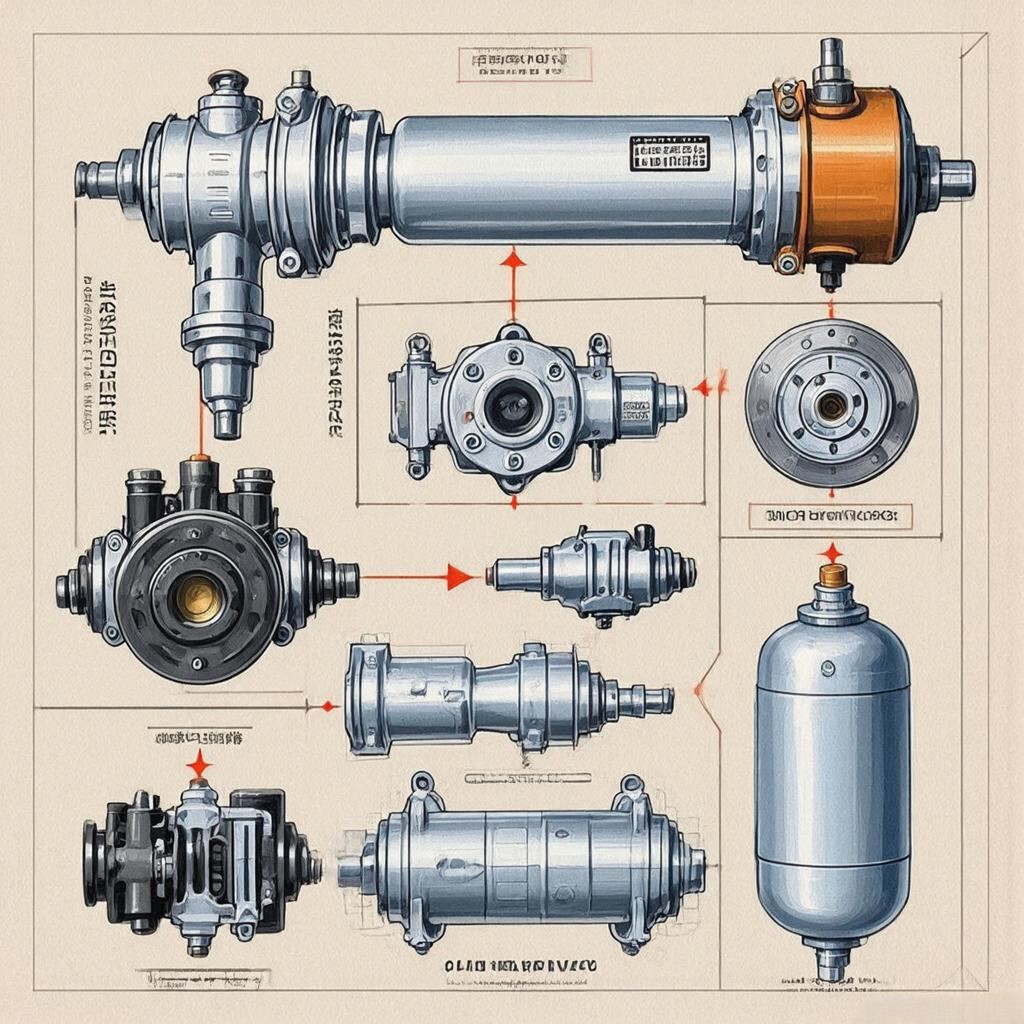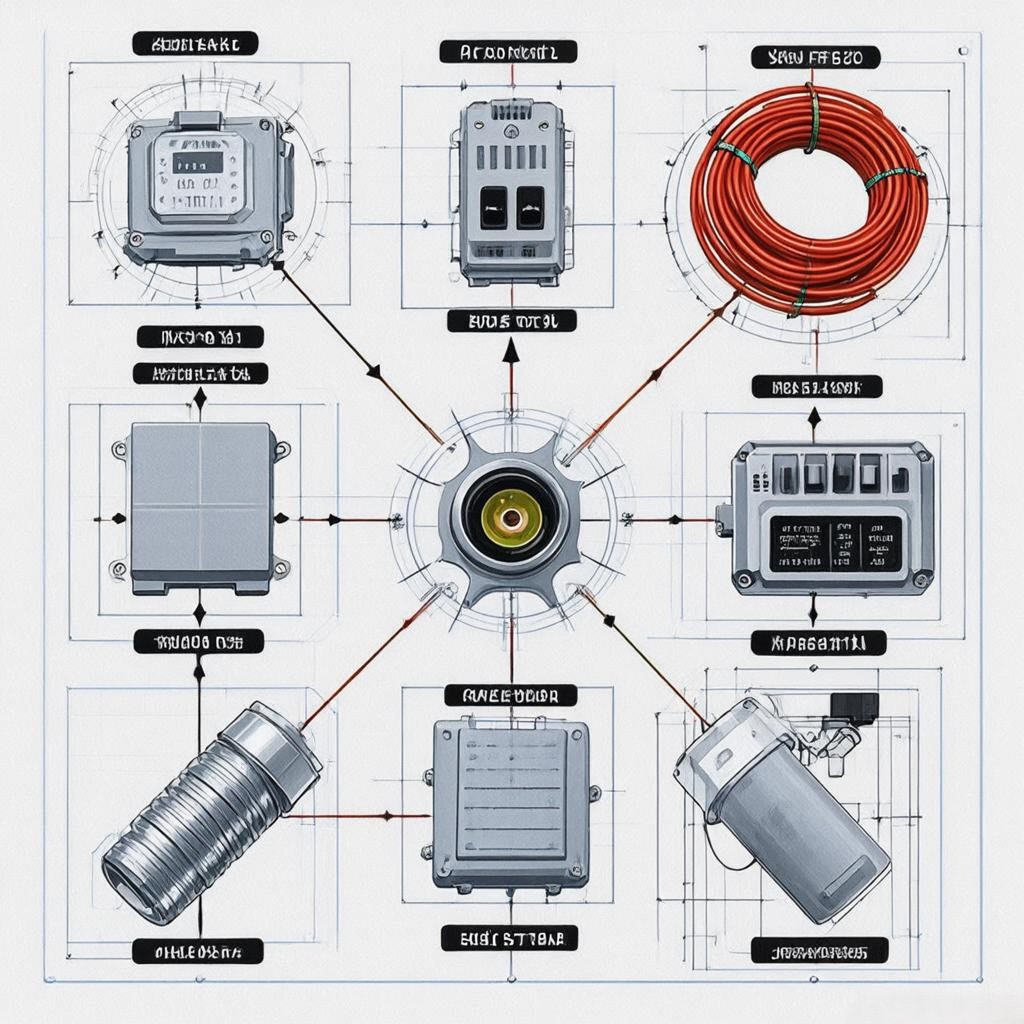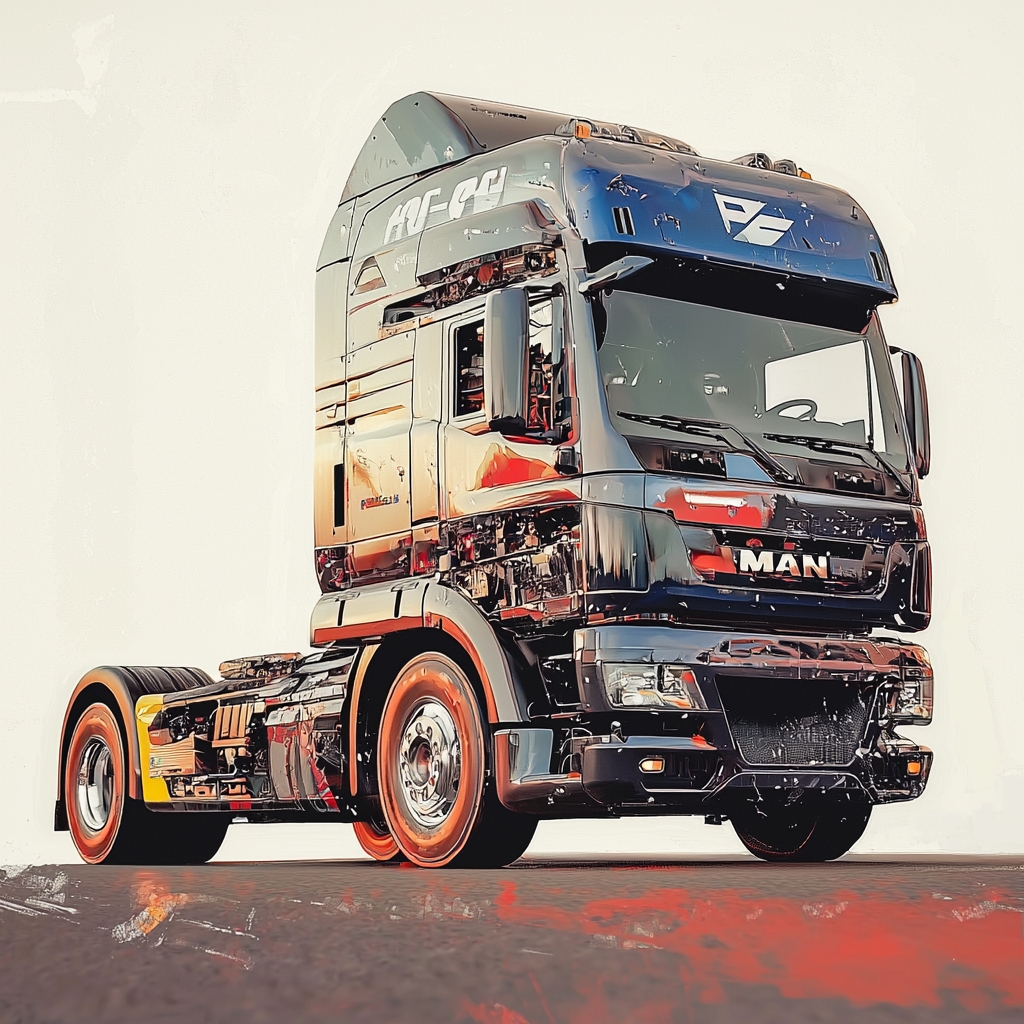Brake systems represent the most critical safety feature in any vehicle, transforming kinetic energy into heat through controlled friction to bring vehicles to a complete stop. Modern brake systems have evolved far beyond simple mechanical linkages, incorporating advanced materials, electronic controls, and sophisticated hydraulics to deliver reliable stopping power under all conditions. This comprehensive technical analysis explores the complete ecosystem of brake components, their functional interrelationships, and how ongoing innovations are shaping the future of vehicle safety.




1. Fundamental Principles of Vehicle Braking Systems
Brake systems operate on fundamental physics principles while meeting stringent safety requirements:
- Energy conversion: Transforming kinetic energy (½mv²) into thermal energy through friction
- Force multiplication: Hydraulic systems amplifying driver input (Pascal’s principle)
- Heat dissipation: Managing temperatures up to 800°C during extreme braking
- Modulation control: Precise adjustment of braking force for stability
Technical specifications:
- Typical deceleration: 0.3g (passenger cars) to 1.2g (race cars)
- Temperature range: -40°C to +800°C operational limits
- Pedal force: 20-100N for full braking (with power assistance)
Industry significance: Brake systems account for 5-15% of total vehicle weight and 10-20% of maintenance costs, while directly influencing 70% of accident prevention scenarios.
2. Core Brake Components and Functional Architecture
2.1 Foundation Brake Components
Disc Brakes (Primary Stopping System)
- Rotors:
- Ventilated cast iron (20-30kg per pair) with directional cooling vanes
- Carbon-ceramic composite (15-25kg) for high-performance applications
- Surface treatments: Zinc plating for corrosion resistance
- Pads:
- Organic compounds (resin-based) for quiet operation
- Semi-metallic (30-40% metal content) for durability
- Ceramic (non-metallic) for low dust and heat resistance
- Calipers:
- Floating design (single piston) for cost-effective applications
- Fixed multi-piston (4-6 pistons) for even pressure distribution
- Materials: High-strength aluminum alloys or ductile iron
Drum Brakes (Secondary/Rear Application)
- Drums: Cast iron construction (15-25kg) with internal friction surface
- Shoes: Organic or low-metallic friction material
- Wheel cylinders: Hydraulic pistons (10-20mm bore) with rubber seals
Performance metrics:
- Disc brake torque capacity: 500-2,000 Nm per wheel
- Drum brake torque capacity: 300-800 Nm per wheel
- Fade resistance: Up to 5 consecutive 1g stops without performance loss
2.2 Hydraulic System Components
Master Cylinder
- Design: Twin-piston (dual circuit) for redundancy
- Bore size: 19-22mm for passenger vehicles
- Fluid capacity: 150-300ml reservoir
- Pressure generation: 100-200 bar (1,450-2,900 psi)
Brake Lines and Hoses
- Steel lines: Double-walled construction with corrosion protection
- Rubber hoses: Reinforced with braided stainless steel
- Flexible sections: Allow for suspension movement (5-10mm deflection)
ABS Modulator
- Valve configuration: 8-12 solenoid valves for individual wheel control
- Pump system: Electrically driven with 1-2L accumulator
- Response time: <100ms for pressure modulation
Technical specifications:
- Hydraulic pressure: 100-200 bar operating range
- Fluid type: DOT 3/4/5.1 with 2-5% water absorption resistance
- Boiling point: >230°C (DOT 5.1) for high-performance applications
2.3 Electronic Control Systems
Anti-lock Braking System (ABS)
- Wheel speed sensors: Hall-effect or inductive types (±1% accuracy)
- Control algorithms: Frequency-based slip detection
- Modulation frequency: 10-20 Hz pulse width modulation
Electronic Brakeforce Distribution (EBD)
- Load sensing: Rear axle pressure adjustment based on weight transfer
- Dynamic allocation: Up to 70% front/30% rear bias in braking
- Response time: <50ms for force redistribution
Brake Assist System (BAS)
- Deceleration threshold: Detects emergency braking (0.3g+)
- Full pressure application: Within 150ms of pedal depression
- Pedal simulation: Maintains consistent feel for driver
Advanced Driver Assistance Systems (ADAS) Integration
- Automatic Emergency Braking (AEB):
- Radar/lidar input processing (10-20 times/second)
- 0.5-1.0g braking force application
- Minimum 40% collision avoidance rate
- Regenerative Braking Coordination:
- Blending friction and electric braking
- Seamless torque transition
- Battery state-of-charge management
3. Advanced Functional Features and Performance Characteristics
3.1 Heat Management and Fade Resistance
Rotor Cooling Technologies:
- Ventilated designs: Directional vanes (30-50% better cooling)
- Drilled/milled surfaces: Enhanced heat dissipation (with wear tradeoffs)
- Carbon-ceramic materials: 3x better fade resistance vs. cast iron
Pad Formulations:
- High-friction compounds: 0.35-0.45μ friction coefficient
- Low-steel formulations: Reduced fade at high temperatures
- Ceramic blends: Stable performance up to 800°C
Thermal Simulation:
- Finite element analysis (FEA): Predicting hot spots and stress points
- Computational fluid dynamics (CFD): Optimizing airflow through rotors
- Temperature mapping: Real-world testing with embedded thermocouples
3.2 Noise, Vibration, and Harshness (NVH) Control
Noise Reduction Strategies:
- Shim technology: Multi-layer rubber/metal isolators
- Slotting patterns: Controlled fracture points in pads
- Rotor coatings: Graphite or molybdenum disulfide treatments
Vibration Damping:
- Caliper piston dampers: Hydraulic or mechanical damping systems
- Mounting system isolation: Rubber bushings with specific stiffness
- Floating caliper designs: Compensating for disc thickness variation
Testing protocols:
- NVH dynamometer testing: 20-100km/h braking simulations
- On-road evaluations: Cold/warm/hot temperature conditions
- Sound pressure level measurement: <70dB(A) target for passenger cars
3.3 Corrosion Protection and Longevity
Surface Treatments:
- Zinc plating: 10-20μm coating thickness for steel components
- E-coating: Cathodic dip painting with 20-50μm film thickness
- Ceramic sealing: Porous metal protection for rotors
Material Selection:
- Corrosion-resistant steels: 4130/4340 alloys for caliper bodies
- Stainless steel components: Springs and hardware elements
- Polymer bushings: Eliminating metal-to-metal contact points
Maintenance intervals:
- Pad replacement: Every 40,000-80,000 km (varies by driving conditions)
- Rotor resurfacing: When thickness variation exceeds 0.1mm
- Fluid flush: Every 2 years or 40,000 km (prevents vapor lock)
4. System Integration and Vehicle Applications
4.1 Passenger Vehicles
- Foundation brakes: Ventilated discs (front), drum (rear) or discs (all-wheel)
- ABS configuration: 4-channel, 4-sensor systems
- ADAS integration: AEB, hill-start assist, and trailer sway control
Performance metrics:
- Stopping distance: 38-45m from 100km/h (dry pavement)
- Pedal feel: Progressive resistance with 10-15% travel variation
- Weight: 30-50kg for complete system (excluding rotors)
4.2 Commercial Vehicles
- Air brake systems:
- Compressed air storage (8-12 bar)
- Spring-applied, air-released parking brakes
- Dual-circuit redundancy for safety
- Drum brake configurations:
- Large-diameter drums (400-500mm)
- Multi-leading shoe designs for increased torque
- Automatic adjusters maintaining consistent clearance
Special considerations:
- Fade resistance: High-mass rotors with enhanced cooling
- Maintenance accessibility: Ground-level service points
- Regulatory compliance: FMVSS 121/ECE R13 standards
4.3 High-Performance and Racing Applications
- Carbon-ceramic brakes:
- 400-600mm diameter rotors
- Specific heat capacity: 800-1,000 J/kg·K
- Fade resistance up to 1,000°C
- Multi-piston calipers:
- 6-10 piston configurations
- Titanium pistons for weight reduction
- Differential bore sizes for pad wear balancing
Track-focused features:
- Pad compounds: High-friction, high-temperature materials
- Rotor cooling: Directed airflow systems
- Brake bias adjustment: Mechanical or electronic control
5. Design Challenges and Engineering Solutions
5.1 Balancing Performance and Wear Characteristics
Solution approaches:
- Friction material formulations: Optimizing for initial bite vs. fade resistance
- Rotor surface treatments: Enhancing bite without increasing wear
- Pad backing plate design: Minimizing deflection under load
Performance targets:
- 50,000+ km pad life (typical driving)
- <2mm rotor wear per 10,000 km
- Consistent performance across temperature ranges
5.2 Meeting Safety and Regulatory Requirements
Key standards:
- FMVSS 135 (USA): Pedal force, stopping distance, and ABS performance
- ECE R90 (Europe): Brake component approval and performance
- GB 21670 (China): Braking system safety requirements
Compliance testing:
- High-speed fade tests: 0.5g deceleration for 15 consecutive stops
- Cold performance tests: -30°C starting conditions
- Water recovery tests: Braking after hydroplaning simulation
5.3 Integration with Electrification and Autonomous Systems
Emerging challenges:
- Regenerative braking coordination: Blending friction and electric braking
- Predictive maintenance: Sensor integration for wear monitoring
- Fail-operational design: Redundant systems for autonomous applications
Technical innovations:
- Brake-by-wire systems: Electronic pedal feel emulation
- Integrated braking modules: Combining ABS, ESP, and regen control
- AI-based braking algorithms: Predictive pressure modulation
6. Testing and Validation Protocols
6.1 Component-Level Testing
Friction material testing:
- Friction coefficient measurement: 0.3-0.5 range verification
- Wear rate testing: 1,000+ cycle durability
- Compression resistance: 100°C to 400°C performance
Hydraulic component testing:
- Leak testing: 20 bar pressure hold for 24 hours
- Corrosion resistance: Salt spray (1,000 hours) and chemical exposure
- Fatigue testing: 10^7 cycle durability for pistons and seals
6.2 System-Level Validation
Dynamometer testing:
- Fade testing: 10 consecutive 0.5g stops
- Recovery testing: Temperature drop after high-load braking
- Water spray tests: Braking performance after hydroplaning simulation
Vehicle testing:
- Stop-from-speed tests: 100km/h to 0 dry/wet conditions
- Mountain descent tests: Sustained braking on 6% gradients
- Low-friction surface tests: Ice, snow, and wet cobblestone
Environmental testing:
- Temperature extremes: -40°C to +80°C operation
- Humidity exposure: 95% RH at 40°C
- Altitude simulation: 5,000m equivalent performance
7. Market Trends and Future Developments
7.1 Electrification and Regenerative Braking
- Blended braking systems:
- Seamless transition between friction and electric braking
- Battery state-of-charge management
- Regen braking torque vectoring
- One-pedal driving:
- 0.1g-0.3g regen braking levels
- Eliminating traditional friction braking in some modes
- Pedal feel emulation algorithms
7.2 Advanced Materials and Manufacturing
- Carbon-ceramic rotors:
- Reduced weight (40-60% vs. cast iron)
- Extended lifespan (2x longer)
- Higher temperature resistance
- 3D-printed caliper components:
- Complex internal cooling channels
- Weight reduction through topology optimization
- Rapid prototyping for development
- Nanocomposite friction materials:
- Enhanced fade resistance
- Reduced dust generation
- Improved cold weather performance
7.3 Autonomous Vehicle Integration
- Predictive braking systems:
- Road condition anticipation
- Traffic pattern analysis
- Driver behavior learning
- Redundant braking architectures:
- Fail-operational electronic control
- Multiple actuation pathways
- Self-diagnostic capabilities
- Brake-by-wire evolution:
- Full electronic pedal control
- Haptic feedback systems
- Customizable brake feel profiles
Conclusion: The Critical Safety Interface
Brake systems represent the most critical safety component in any vehicle, combining mechanical precision, electronic control, and material science to deliver reliable stopping power. As vehicles become more sophisticated with electrification and autonomous driving capabilities, brake systems must continue evolving to meet new challenges:
Key takeaways:
- Modern brake systems integrate mechanical, hydraulic, and electronic components for comprehensive safety
- Advanced materials and manufacturing are pushing performance boundaries
- Integration with ADAS and electrification requires new engineering solutions
- Sustainability and digitalization are shaping the next generation of braking technology
Final thought: In an era where vehicles are becoming increasingly autonomous and electrified, the fundamental importance of reliable braking systems has never been greater. The next generation of mobility will depend on these critical systems to safely manage the transition between automation and driver control, ensuring passenger protection in all scenarios. The ongoing evolution of brake technology represents both a technical challenge and an opportunity to redefine vehicle safety standards for the future.
Call to Action
🔧 Upgrading your vehicle’s braking system?
⚙️ Consider advanced materials and electronic integration for superior performance
📊 Request comparative analysis of traditional vs. high-performance brake solutions
#BrakeTechnology, #VehicleSafety, #ADASIntegration, #Electrification, #AdvancedMaterials, #AutomotiveEngineering, #FunctionalSafety, #SmartMobility, #FutureOfTransportation




